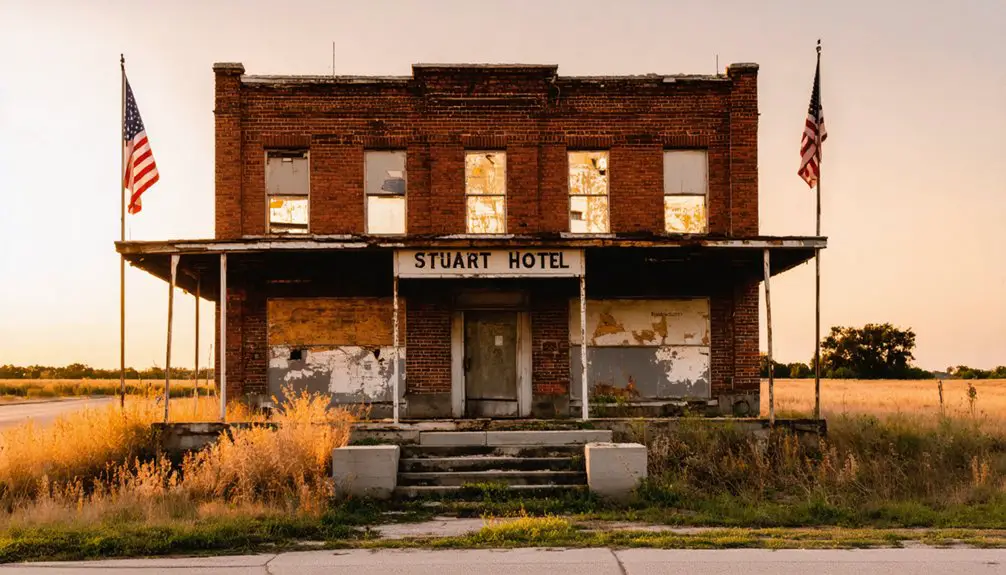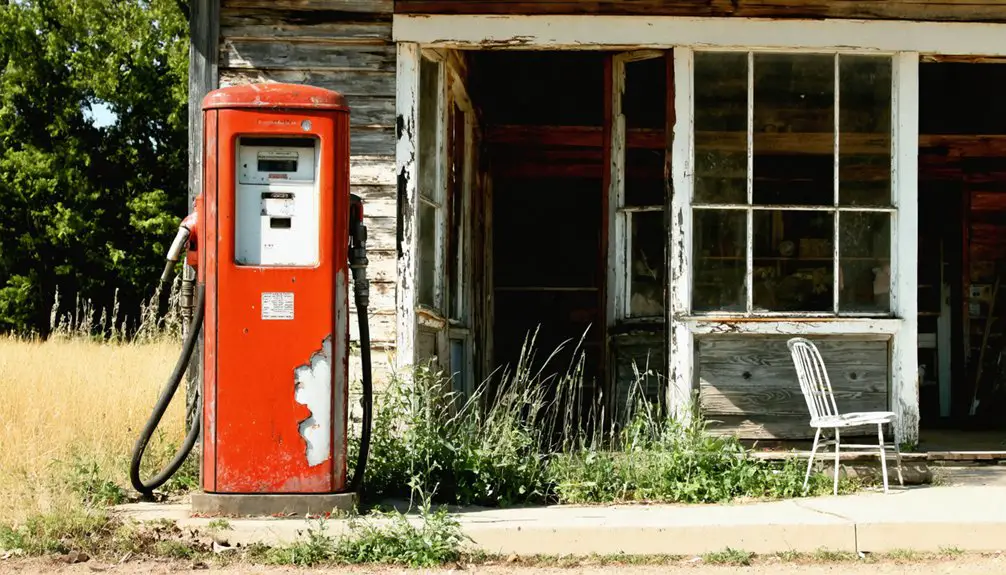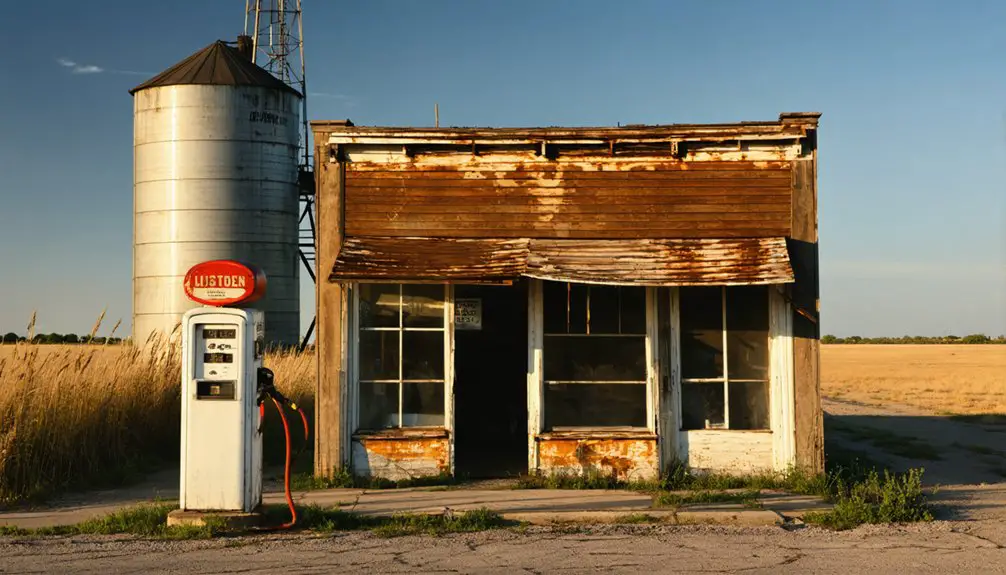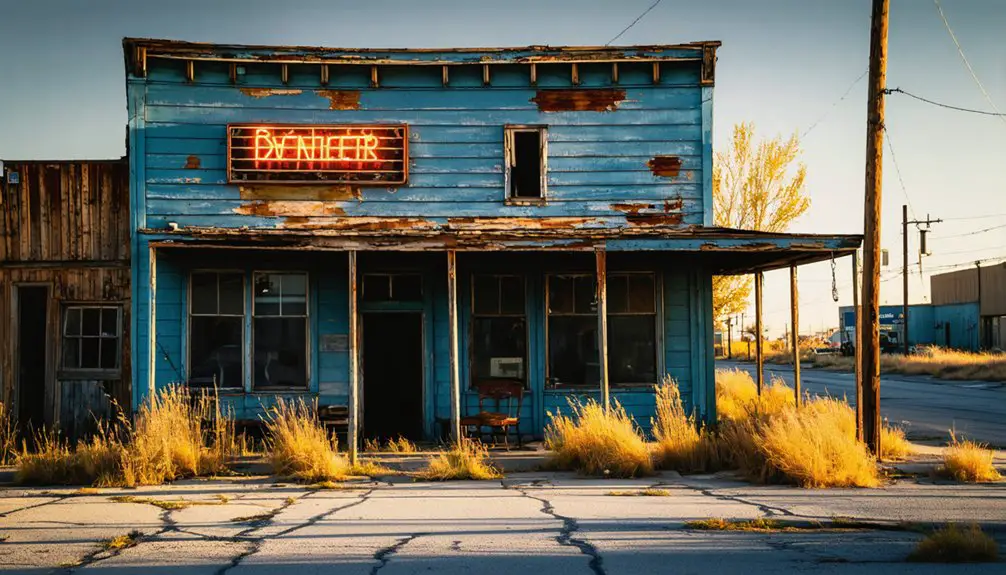You’ll find Stuart’s ghost town remnants along U.S. Highway 270 in Hughes County, Oklahoma, where a thriving railroad community once flourished. Originally called Hoyuby, the town was renamed in 1896 after Judge Charles Bingley Stuart and grew into a bustling agricultural hub with banks, stores, and churches. The population peaked at 535 in 1930, but today fewer than 180 residents remain, with historic structures telling tales of the community’s golden age.
Key Takeaways
- Stuart, Oklahoma declined from 535 residents in 1930 to just 180 by 2010, transforming from a bustling town to near-ghost town status.
- The town’s economic decline began during the Great Depression, leading to the closure of local banks, cotton gins, and stores.
- By 2000, over 93% of Stuart’s employed residents commuted elsewhere for work, effectively turning it into a bedroom community.
- Historic structures like the 1918 limestone jailhouse and old churches remain as physical reminders of Stuart’s former prominence.
- The bypass of Stuart by the Interstate Highway System contributed to its isolation and eventual decline into near-abandonment.
The Birth of a Railroad Town
When the Choctaw, Oklahoma and Gulf Railroad laid tracks through the settlement of Hoyuby in 1895, it sparked the transformation of a small community into the bustling town of Stuart. The railroad’s influence quickly attracted businesses, workers, and settlers seeking opportunities in this strategic location between McAlester and Oklahoma City.
The railroad’s arrival in 1895 transformed Hoyuby from a quiet settlement into Stuart, drawing ambitious settlers to this promising new frontier.
You’ll find the town’s very identity changed with this evolution – the Hoyuby post office was renamed Stuart in 1896, honoring Judge Charles Bingley Stuart. Like many Justice Stuart officials of the era, he played a pivotal role in shaping the region’s development.
The Wooleys stepped forward in 1904, providing land for the formal townsite as economic growth surged. New enterprises sprouted up, including blacksmith shops, lumberyards, cotton gins, and the Texas Pipe Line Company. The town experienced significant growth until reaching a population of 535 in 1930.
The Stuart Hotel, built in 1901, became a social hub where railroad workers and travelers found rest and community.
From Hoyuby to Stuart: A Name’s Evolution
You’ll find Hoyuby’s origins in the Choctaw Nation, where the settlement took its name from a local Choctaw allottee before establishing its post office in 1892.
The town’s identity transformed in 1896 when officials changed the name to Stuart, honoring the influential Judge Charles Bingley Stuart of McAlester, Oklahoma.
This change resolved the confusion caused by various spellings of Hoyuby and marked the beginning of the community’s growth alongside the expanding railroad. The arrival of the Choctaw, Oklahoma and Gulf Railroad in 1895 helped establish Stuart as a developing community. The town flourished into a bustling community with a population of 900 during the early 1900s.
Origins of Hoyuby Name
The small settlement of Hoyuby emerged from the heart of Choctaw Nation in Indian Territory, taking its name from a local Choctaw allottee. This early community reflected its deep Choctaw heritage through its Native naming, which proved challenging for settlers to standardize in written form.
When you look back at Hoyuby’s beginnings, you’ll find:
- A post office established in 1892 with John H. Elliott serving as the first postmaster
- Multiple spelling variations of the name, showcasing the complexity of preserving Native names in written records
- A gradually developing settlement that maintained its Choctaw character until the railroad’s arrival in the mid-1890s
The name Hoyuby stood as a reflection of the area’s indigenous roots before the transformation that would reshape this corner of Indian Territory.
Judge Stuart’s Lasting Impact
Judge Charles Bingley Stuart’s influence transformed Hoyuby into a thriving railroad town that would forever bear his name. His legal influence extended far beyond the town’s renaming in 1896, as he served as both a federal judge and attorney for the railroad company that brought crucial commerce to the region.
After serving as chief justice of the Indian Territory appellate court, his leadership helped shape the region’s development. His descendants continued making an impact, as demonstrated by his grandson’s service as youngest judge in Oklahoma in 1941. You’ll find his family legacy woven throughout Stuart’s development, particularly through his son Royal C. Stuart’s leadership in local banking. Together, they helped establish essential infrastructure and services, from cotton gins to financial institutions.
While the town has faced economic changes over the decades, Stuart’s impact endures through landmarks like the historic Stuart Hotel and the lasting transportation infrastructure he helped establish through his railroad connections. His contributions shaped not just a town’s name, but its entire foundation.
Post Office Name Change
Before becoming Stuart, a small settlement called Hoyuby served as home to an essential post office established on June 23, 1892, in Indian Territory’s Choctaw Nation. The post office’s postal significance grew as John H. Elliott, the first postmaster, helped connect the growing community to the outside world. Like many early Oklahoma settlements, the consolidation of post offices influenced the development of the local community.
- Various spellings of “Hoyuby” created confusion in mail delivery
- The name honored a Choctaw allottee, reflecting the area’s Native American heritage
- The railroad’s arrival in 1895 increased the need for clear postal identification
On April 14, 1896, you’ll find the pivotal moment when the post office adopted the name “Stuart,” honoring Judge Charles Bingley Stuart of McAlester. This change strengthened the community identity and marked a shift that aligned with the settlement’s growth and modernization.
Golden Age of Commerce and Agriculture
During Stuart’s prime years, five bustling general stores anchored a thriving commercial district that served the region’s agricultural needs.
You’d find two banks supporting farmers’ financial ventures, while blacksmith shops kept farm equipment running smoothly. Two lumberyards supplied materials for expanding farms and the growing town.
Agricultural innovations flourished as farmers experimented with crop rotation and diverse plantings including cotton, corn, oats, and various beans. Local farmers participated in Aggie Day competitions that showcased their agricultural achievements.
The community’s resilience showed through their response to challenges like the Dust Bowl, developing water containment solutions in 1929.
Facing severe drought and dust storms, Stuart’s farmers innovated with water storage systems, demonstrating remarkable adaptability during environmental hardship.
The Stuart Ranch, Oklahoma’s oldest family-owned ranch, exemplified this pioneering spirit through its successful cattle operations and adaptive management practices. The ranch’s dedication to land stewardship is evident in their commitment to passing on better land to future generations.
Their Black Baldie breeding program and 16,000+ acre operation became a cornerstone of local agricultural success.
Historic Stuart Hotel Legacy

Among Stuart’s most enduring landmarks, the Stuart Hotel stands as a tribute to the town’s economic importance in the early 1900s. Built by B.A. Nunn and Mary Youngblood Nunn between 1901-1903, this two-story structure hosted countless railroad workers and pipeline laborers who shaped Stuart’s development. The historic building features a distinctive hipped roof design that exemplifies early 20th-century architecture.
The hotel’s stories paint a fascinating picture of early Oklahoma life:
- U.S. Marshal Crockett Lee conducted business from its rooms
- Notorious outlaw “Pretty Boy” Floyd secretly used Room #6 via an outside stairway
- Local women found employment as cooks and cleaners until the mid-1930s
While the building closed in 1968 and now faces serious preservation challenges, it remains protected on the National Register of Historic Places – a symbol of Stuart’s once-thriving role as a commercial and transportation hub.
Religious and Social Life in Early Days
As Stuart took shape in the early 1900s, three prominent churches – Baptist, Christian, and Methodist – emerged as the town’s spiritual and social backbone.
Three faiths laid Stuart’s foundation in the 1900s, with Baptist, Christian and Methodist churches anchoring community life.
These religious institutions served far beyond worship, providing essential spaces for community gatherings when public facilities were scarce. You’d find churches hosting everything from social clubs to educational programs, weaving together Stuart’s diverse settlers into a tight-knit community.
The churches’ influence extended deep into daily life, with spiritual leaders guiding both personal and civic matters.
Through Sunday schools, youth groups, and charitable events, they fostered literacy, social stability, and mutual support. Their buildings, among Stuart’s earliest permanent structures, became centers where you’d witness baptisms, weddings, and holiday celebrations that united the entire town in shared traditions and values.
Economic Decline and Population Shifts

While Stuart thrived in the early 1900s with a bustling agricultural economy, the town’s fortunes began a steep decline that would reshape its destiny. The economic change hit hard during the Great Depression, as farmers lost their land and residents sought opportunities elsewhere.
By 2000, you’d find over 93% of employed residents commuting to nearby towns for work.
The demographic changes tell a stark story of Stuart’s transformation:
- Population plummeted from 535 in 1930 to just 180 by 2010
- Local banks, cotton gins, and stores gradually disappeared
- The town shifted from an agricultural hub to a bedroom community
The loss of railroad importance and failure to diversify industry sealed Stuart’s fate, though a small residential population persists today.
Transportation Hub and Regional Connections
Stuart’s transportation legacy began with the arrival of the Choctaw, Oklahoma and Gulf Railroad line, which would later become part of the Chicago, Rock Island and Pacific Railway.
You’ll find that this rail connection positioned Stuart as an essential link between McAlester and Oklahoma City, with the town serving as a significant watering station for steam locomotives in the 1930s.
The town’s regional significance grew through its strategic location at the intersection of State Highway 31A and U.S. Highway 270.
As a transportation hub, Stuart supported the surrounding agricultural community with cotton gins, blacksmith shops, and livery stables.
However, the transportation evolution from rail to highways dramatically changed Stuart’s role.
When the Interstate Highway System bypassed smaller towns and rail services declined, Stuart’s prominence as a regional connector began to fade.
Notable Structures and Landmarks

Despite the passage of time, several notable structures in Stuart remain as proof of the town’s vibrant past. The town’s historic architecture tells a story of community significance, with the 1918 limestone jailhouse standing as the most well-preserved example of early law enforcement buildings in the region.
- The Main Street once showcased a mix of wooden and brick commercial buildings where merchants served the daily needs of Stuart’s residents.
- Churches and community halls, though mostly in ruins now, mark the locations where townspeople gathered for spiritual and social connections.
- Pioneer-style homes, industrial structures, and utility buildings dot the landscape, offering glimpses into the working lives of Stuart’s former inhabitants.
These surviving landmarks serve as silent witnesses to Stuart’s evolution from a bustling community to its current ghost town status.
Modern Day Remnants and Heritage
Today, the remnants of Stuart offer a poignant glimpse into Oklahoma’s vanishing frontier heritage.
You’ll find the 1918 limestone jail still standing as a symbol of the town’s past, while most other structures have succumbed to time and nature. The once-bustling streets have largely transformed into agricultural land and natural growth, reflecting the ecological transformation common to Oklahoma’s ghost towns.
Modern preservation efforts have documented Stuart’s significance through historical research and museum exhibits, ensuring its story isn’t lost to time.
While the town’s population has dwindled dramatically, matching the fate of many similar communities that have lost over 80% of their residents, dedicated historians and preservationists continue recording its history.
The remaining physical evidence, though limited, provides valuable insights into early Oklahoma settlement patterns and community life.
Frequently Asked Questions
What Natural Disasters or Major Events Contributed to Stuart’s Population Decline?
You won’t find specific natural disasters directly causing Stuart’s population decline. Instead, gradual economic changes, shifting transportation patterns, and regional agricultural downturns slowly drew people away from your community.
Are There Any Famous People or Celebrities Who Originated From Stuart?
You won’t find any celebrity connections or famous residents originating from Stuart. While Judge Charles Stuart and his son Royal influenced local banking, they weren’t widely known beyond regional importance.
What Native American Artifacts Have Been Discovered in the Stuart Area?
Like buried treasures beneath your feet, Native artifacts around Stuart include projectile points from the Archaic period, decorated pottery sherds from Mississippian times, stone tools, painted bones, and cordmarked ceramics from archaeological findings.
Does Stuart Hold Any Annual Festivals or Community Gatherings Today?
You won’t find any annual celebrations or community events in Stuart today, as its ghost town status means there’s no active population to organize or participate in regular gatherings.
What Were the Major Crimes or Law Enforcement Challenges in Stuart’s History?
You’ll find Stuart’s oldest unsolved case from 1926, when a man was killed by shotgun wounds. The Ashley Gang’s violent presence and limited law enforcement resources created significant challenges controlling crime.
References
- https://usghostadventures.com/stuart-ghost-tour/
- https://en.wikipedia.org/wiki/List_of_ghost_towns_in_Oklahoma
- https://en.wikipedia.org/wiki/Stuart
- https://www.okhistory.org/publications/enc/entry?entry=ST054
- http://www.ou.edu/news/articles/2024/may/ou-researcher-unveils-book-of-oklahomas-ghost-towns.html
- http://genealogytrails.com/oka/hughes/cities.html
- https://npgallery.nps.gov/NRHP/GetAsset/NRHP/82001496_text
- https://www.redriverhistorian.com/post/stuart-s-malaria-ditch
- https://waymarking.com/waymarks/wm17DZ3_Stuart_OK
- https://www.okhistory.org/publications/enc/entry?entry=ST061



